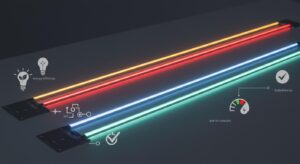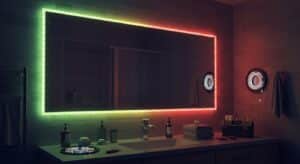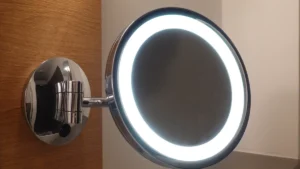
LED light strips are useful and easy to customize. They are popular for home and decorative lighting. You can cut LED light strips to the length you need, and this will not harm how they work. Makers add special cut points so you can safely adjust cut LED light strips.
Key Takeaways
Always cut LED strips at marked points to avoid breaking the circuit. This keeps your lights working properly.
Use sharp tools like scissors or a utility knife for clean cuts. Dull tools can damage the wires inside the strip.
Reconnect cut strips carefully by matching the ‘+’ and ‘-‘ sides. Use solderless connectors for easy fixes or solder for stronger connections.
Tools and Materials for Cutting LED Strip Lights
Tools needed for neat and accurate cuts
To cut LED strip lights, you need proper tools. Use sharp scissors or a utility knife for smooth cuts. Clean cuts keep the wires inside safe and working well. Dull tools can harm the wires, so sharp ones are important. For RGBIC or Hue Lightstrips, a box cutter or hobby knife might work better.
A voltage tester is also very helpful. It checks if electricity is flowing before you cut. This keeps you safe and avoids accidents. If you want to reconnect the strips, a soldering iron and solder are great for strong connections.
Tool | Purpose |
|---|---|
Sharp Scissors/Utility Knife | Makes smooth cuts, protecting the wires inside. |
Voltage Tester | Checks for electricity, keeping you safe. |
Soldering Iron and Solder | Helps make strong connections for cut strips. |
Heat-shrink tubing/Silicone Sealant | Shields cut ends from water and dust outdoors. |
LED Strip Connectors | Easy way to reconnect strips without soldering. |
Materials for reconnecting cut LED strip lights
To reconnect LED strips, you’ll need certain materials. Solderless connectors are simple and easy to use. They don’t need special tools, making them great for beginners. For stronger connections, use a soldering iron and solder. This method lasts longer and spreads power better.
When reconnecting, line up the copper dots on both strip ends. Make sure the ‘+’ and ‘-‘ sides match to keep them working. Use heat-shrink tubing or silicone sealant to protect the ends from water and dust, especially outside.
Safety steps to follow before cutting
Always stay safe when working with LED strips. Turn off the power before cutting to avoid shocks. Use sharp scissors or a cutting tool to avoid harming the wires. Cover the cut ends with heat-shrink tubing or silicone sealant to keep them safe.
Don’t overload circuits to avoid fires or problems. Measure the space where you’ll put the strips first. This helps you cut the right length and avoid mistakes.
Tip: Check if your power supply works with your LED strips for safe use.
Step-by-Step Guide to Cut LED Light Strips
How to find the cut points on LED strips
Before cutting, look for the cut marks on your LED strip. These marks are often dotted lines or small scissor icons. They show where it’s safe to cut without breaking the circuit. Never cut outside these marks, or the strip might stop working.
Check for shiny copper pads near the cut marks. These pads are important for reconnecting the strip later. Always double-check the markings to make sure you cut in the right spot.
How to cut LED strip lights correctly
Cutting LED strips needs care and accuracy. Use sharp scissors or a utility knife to cut straight along the marked line. Dull tools can harm the wires inside and cause problems. Hold the strip steady and don’t bend it while cutting, as bending can damage it.
If the strip will be used outside or in wet areas, seal the ends. Use heat-shrink tubing or silicone to protect it from water and dust. Always unplug the power before cutting to stay safe from shocks.
How to reconnect cut LED strip lights
Reconnecting cut LED strips is simple. Use solderless connectors for an easy fix. These connectors join the copper pads on both ends and keep the polarity correct. For a stronger connection, use a soldering iron to attach the ends. Match the ‘+’ and ‘-‘ sides to keep it working.
To make the strip longer, add a power wire between the cut pieces. This method works well for bigger setups. Cover the connections with heat-shrink tubing or silicone to protect them from water and dirt.
Testing the LED strip lights after cutting
After cutting and reconnecting, test the strip to see if it works. Plug it back in and check if the lights are bright and steady. If they flicker or don’t turn on, check the connections and polarity. Testing makes sure your LED strip is ready to use and avoids future problems.
Tip: Measure the space where you’ll place the strip before cutting. This helps you avoid mistakes and ensures it fits perfectly.
Troubleshooting LED Strip Lights Not Working
Fixing problems with LED strips not lighting up
If your LED strip lights don’t work, check the power source first. Make sure it’s plugged in and working properly. Look for any visible damage on the strip, like cuts or broken parts. Check the copper pads where you made cuts, as misaligned connections can cause issues.
Use a voltage tester to see if electricity is flowing through the strip. If it still doesn’t light up, check the connection points. Loose or wrong connections can stop the circuit from working. Reconnect the strip carefully, making sure the copper pads line up correctly.
Tip: Always test the strip after fixing it to ensure it works.
Solving flickering or uneven brightness
Flickering or uneven brightness happens when connections are bad or power is too low. Check if the power supply matches your LED strip’s voltage and wattage needs. A weak power source often causes flickering problems.
Look at the connections between strip sections. Loose or dirty connections can make the lights dim or uneven. Clean the copper pads and reconnect them tightly. If the issue continues, use a voltage tester to find weak spots in the connection.
Note: Test the strip after every fix to confirm the problem is solved.
Keeping alignment and power steady
Good alignment and a strong power supply are key for LED strips to work well. When reconnecting cut strips, make sure the copper pads match up perfectly. Misaligned pads can break the circuit. Use solderless connectors or a soldering iron for a secure connection.
Check if your power supply can handle the strip’s total length. If the strip is too long, the power source might fail. Add a power booster if you extend the strip to keep brightness even. Always test the strip after changes to make sure it works properly.
Reminder: Regularly test the strip to spot and fix problems early.
Best Practices for Cutting and Reconnecting LED Strips
Tips for keeping LED strips strong and working
To keep LED strips working, focus on keeping them strong. Don’t bend or twist the strips when installing them. Sharp bends can break the wires inside. Use sharp tools to cut cleanly and avoid rough edges. Cover the cut ends with heat-shrink tubing or silicone, especially outdoors.
Use good connectors to join cut pieces. Strong connections stop power loss and keep brightness steady. If using connectors, check the copper pads line up correctly. Look at the strips often for damage, especially in busy areas.
Tip: Test the strips after each change to find problems early.
How to store and handle LED strips properly
Store LED strips in a dry, clean place to keep them safe. Roll them loosely to avoid bending or breaking the circuit. Keep them away from sunlight and extreme heat or cold.
Be gentle when handling the strips during setup. Don’t pull or stretch them, as this can break the wires. Use connectors to join pieces instead of forcing them together. Make sure the connectors match your strip type.
Reminder: Label stored strips with their voltage and type for easy use later.
Picking the right connectors and power supply
Choose the right connector for your LED strips. Match the connector to the strip’s size and type. For RGB or RGBIC strips, use connectors made for multi-channel circuits. Make sure connectors fit tightly to avoid loose connections.
Pick a power supply that matches your strip’s voltage and wattage. A weak power supply can cause flickering or dim lights. For long strips, add a power booster to keep the lights even.
Note: Always test your setup after connecting to make sure it works.
Cutting LED light strips becomes easy when you follow the right steps. Always cut at the marked points to avoid damaging the circuit. Reconnect the strips carefully and test them to ensure they work.
Tip: By using proper tools and techniques, you can customize your LED strips while keeping them functional and long-lasting.
FAQ
Can you cut LED strips anywhere?
No, you must cut LED strips only at marked spots. These spots keep the circuit working and the strip functional.
What happens if you cut outside the cut marks?
Cutting outside the marks breaks the circuit. The strip might stop working, and fixing it becomes harder. Always cut exactly at the marked spots.
Do you need special tools to reconnect LED strips?
No, beginners can use solderless connectors easily. For stronger fixes, a soldering iron works better. Both options keep the strip aligned and working.
Tip: Test the strip after reconnecting to make sure it works.
See Also
Steps To Properly Cut A Cob Led Strip
Selecting The Perfect LED Strip Lights For Linear Lighting
Effective Installation Tips For LED Strip Lights In 2025
Best Practices For Installing RGB LED Strip Lights
Understanding Cob Led Strips And Their Functionality



